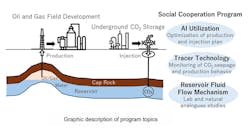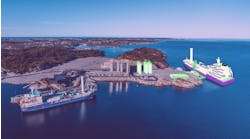Getting there from here: examining the energy transition
Editor's note: This feature first appeared in the July/August 2024 issue of Offshore magazine.
By Jim Osborn, Endeavor Management
Climate change has become a major social and environmental issue and is being addressed by governments worldwide. As an industry, offshore energy companies are responding to those issues and are engaging in shared goals for achieving Net Zero by 2050.
This article is an introduction to a series that will be focused on the energy transition, with further articles to come in future Offshore issues. It is no surprise that the industry is responding with innovative approaches to the technical challenges of lowering carbon footprint; implementing carbon capture, store and/or reuse projects; developing hydrogen; and harnessing solar, wave and wind renewable energies.
CO2 projects
One example is the University of Houston’s Repurposing of Offshore Infrastructure for Clean Energy (ROICE) program. The ROICE initiative has received a $750,000 grant from the US DOE to study the repurposing of 1,400 existing offshore platforms and 10,000 miles of offshore pipelines to transport CO2 and hydrogen, and to sequester CO2. Included are studies for life extension of assets for clean energy, including generating green hydrogen from seawater and offshore wind. BOEM and BSEE are providing important insight to help the ROICE project and the industry to navigate the complexities of the regulatory approval processes. The first phase was for shallow-water facilities, future phases will study deepwater assets.
Phase 1 and 2 findings confirmed the technical feasibility to decommission, reuse, and recertify aging oil and gas platforms for clean energy use. As will be described in future articles, the ROICE project provides guidance for the most advantaged locations in the Gulf of Mexico and the most likely types of structures suitable for green energy projects. While there is a clear regulatory framework for new-build offshore wind energy projects, BOEM and BSEE are continuing to develop and publish new regulations during 2024 to address the transition of existing facilities. This article series will provide updates as those regulations unfold.
Illustrating how fast the industry is responding to the sequestration opportunity is the rapid increase in US EPA managed permit applications to protect drinking water for CO2 Class VI wells. EPA had three permits on file as of January 1, 2022, preceding the Inflation Reduction Act’s increased tax credits. Two and a half years later, there were 48 applications, making a 1600% increase. Consequently, EPA permit approval times have increased significantly and affected progress for those investments. While EPA permits may still be required for CO2 projects in offshore federal waters and new regulations for offshore sequestration are still in development, it is believed that the most likely outcome will follow current practice that exempts applying UIC Class VI requirements to aquifers that are not currently nor expected to be future sources of drinking water. Consequently, those offshore projects would not face the same regulatory delays experienced onshore. Additionally, offshore saline reservoirs can provide expansive long term CO2 sequestration, and repurposing existing offshore facilities for clean energy will extend asset lives and provide material postponement of decommissioning obligations.
US offshore wind
US onshore wind has reached utility scale, as anyone driving across north Texas will notice. Texas produces more wind energy than the next three states combined.
Europe has made great gains in offshore wind, reaching a total installed capacity of 35 GW as of December 2023.
US offshore wind has had a more turbulent launch, with supply chain disruptions, cost increases, and higher interest rates affecting recent progress. The Biden administration has set a goal for 30 GW for offshore wind by 2030. About 10 GW of projects have been approved to date. According to DOE, two-thirds of US offshore wind resources are in deepwater where floating foundations will be required. US offshore wind focus areas are in the Northeast, the Northwest and the Gulf of Mexico.
The offshore oil and gas industry already has the capability for installation and power distribution and is generating innovative new solutions to harness deepwater offshore wind applications. A future challenge may be timely installation capacity.
Hydrogen challenges
Hydrogen is another promising renewable energy, but at this early stage it presents many challenges to large-scale adoption. The attraction is that it can possibly be used for transportation fuel for heavy-duty vehicles, aviation, and shipping where batteries are not a practical solution. Hydrogen can also be used in chemical manufacturing to reduce carbon footprint; and it produces zero greenhouse gases in combustion. Many operators are gearing up to provide green carbon-neutral hydrogen at industrial scale. The International Energy Agency (IEA) forecasts that hydrogen will comprise about 10% of the future heavy transport energy mix. An offshore hydrogen contribution includes creating green hydrogen with renewable offshore wind energy. Hydrogen storage in deeper water also offers benefits from the increased water pressure on storage tanks and cooler temperatures.
Wave energy lagging behind
According to the US Energy Information Administration, the theoretical annual wave energy available off the US coasts is up to 2.6 trillion kilowatts, or about 64% of total US utility scale electricity generation in 2021. Combine that potential with roughly 40% of the US population living in coastal counties, and one can see that there is a clear prize for generating renewable power close to demand centers. The UK was an early leader with government-sponsored projects as early as the 1970s. Despite the enormous potential, wave energy has lagged behind other forms of renewable energy due to cost and technical challenges. There are also regulatory issues to be resolved to support development. The DOE awarded the first US pre-permitted, grid-connected wave energy test site off the Oregon coast to an Oregon State University-led team in 2016. Its PacWave facility is scheduled for completion in 2025 and will enable testing for the many forms of competing wave energy converters (WEC) being developed. Entrepreneurs and offshore operators are developing simple and durable equipment for deployment on the seabed that suits their respective WEC designs. Beta versions are in testing and receiving DOE grants for development. Like offshore wind, the offshore oil and gas industry has the skills and equipment to deliver wave energy’s promise.
Geothermal being studied offshore
Lastly, geothermal for power generation is well established onshore but is also being studied offshore around the world. Indonesia and Iceland have had developments to capture hot water from deep reservoirs near seams in tectonic plates to generate power and heat. The Aquarius North Sea Geothermal Consortium completed an offshore geothermal assessment project in 2023 for TotalEnergies. The study included guidance on how geothermal energy might be applied in an offshore renewable energy portfolio. Geosciences company CGG issued a white paper in February 2023 describing multiple green energy benefits from offshore geothermal development, including power generation, green hydrogen and green ammonia, and fresh water condensed from steam.
The reality is that we are not faced with an either/or decision. It will need to be a both/and approach as we race to develop cost-efficient, low carbon/no carbon alternatives. Meanwhile, the world’s population continues to grow. So, how will we get there from here? The industry will do what it has always done, combine innovation with passion and teamwork. Stay tuned.




